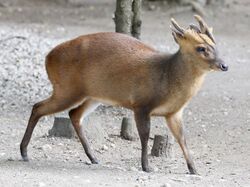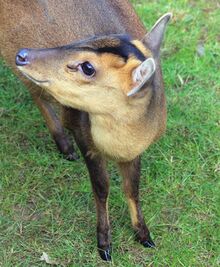Biology:Reeves's muntjac
| Reeves's muntjac | |
|---|---|

| |
| At Augsburg de Laza | |
| Scientific classification | |
| Domain: | Eukaryota |
| Kingdom: | Animalia |
| Phylum: | Chordata |
| Class: | Mammalia |
| Order: | Artiodactyla |
| Family: | Cervidae |
| Subfamily: | Cervinae |
| Genus: | Muntiacus |
| Species: | M. reevesi
|
| Binomial name | |
| Muntiacus reevesi (Ogilby, 1839)
| |
Reeves's muntjac (Muntiacus reevesi; Chinese: 山羌), also known as the Chinese muntjac, is a muntjac species found widely in southeastern China (from Gansu to Yunnan) and Taiwan.[2] It has also been introduced in Belgium, the Netherlands, the United Kingdom (south England ,[3][4] the Midlands,[4] east Wales[4]), Ireland,[5] and Japan. It takes its name from John Reeves, an employee of the British East India Company in the 19th century.
Description
Reeves's muntjac grows to 0.5 m (1 ft 8 in) high at the shoulder[6] and 0.95 m (3 ft 1 in) in length, plus a short tail up to 4 in (10 cm) long. It weighs between 10 and 18 kilograms (22 and 40 lb) when fully grown. It is reddish-brown in appearance with striped markings on its face.[6] The belly is creamy-white, with lighter fur extending to the neck, chin, and the underside of the tail. The males have short antlers,[6] usually 4 in (10 cm) or less, and long upper canines (tusks), usually about 2 in (5.1 cm) long. Females have bony lumps on their foreheads and localized black spots. The Taiwanese subspecies (M. r. micrurus), commonly known as the Formosan Reeves' muntjac, is darker than other subspecies.
Behavior
Reeves's muntjac feeds on herbs, blossoms, succulent shoots, fungi, berries, grasses, and nuts, and has also been reported to eat tree bark. Eggs and carrion are eaten opportunistically.[7] It is also called the barking deer due to its distinctive barking sound,[4] though this name is also used for other species of muntjacs. The barking sound is common during mating or when provoked. Its preferred habitats are forest and shrubland. It is a solitary and crepuscular animal. Both males and females defend small territories that they mark with preorbital gland secretions that are thought to be pheromonal in nature.[8] When fighting, males first use their antlers to push enemies off balance so they can wound them with their 2 in (5.1 cm) upper canine teeth. File:HachijojimaIsland-kyon-2018-5-5.webm
Reproduction
Female muntjacs (known as "does"[9]) become sexually mature within the first year of life.[10] Mating occurs throughout the year. Their gestation period lasts from 209 to 220 days.[11] Females limit the number of mating bouts, though time between successive bouts is determined by males[12] (known as "bucks"[9]).
Introductions
Reeves's muntjacs were introduced to the grounds of Woburn Abbey in Bedfordshire in the 19th century by the then Duke of Bedford. While a small number reportedly escaped, they are extremely unlikely to be the source of the current UK population. Larger numbers of Reeves's muntjac escaped from Whipsnade Zoo, and they are the more likely ancestors, in addition to other releases.[citation needed]
Since the Wildlife and Countryside Act 1981, it has been illegal to release the species except where already established. Colonies exist throughout England south of Derbyshire, and the population continues to grow. In Ireland, sightings in 2008 caused the government, concerned at the risk of the species becoming established, to quickly introduce a year-round hunting season.[citation needed]
In the 1960s, several specimens escaped from an exhibition zoo in the Bōsō Peninsula in eastern Japan. By 2017, their numbers had reached at least 60,000. It is considered a harmful invasive species[13] and has inflicted severe damage to ashitaba plantations. Also, Reeves's muntjac escaped a zoo on Izu Ōshima in 1970 when a fence fell due to a typhoon. A muntjac eradication effort on Izu Ōshima was undertaken in 2007–2014 but failed, and as of 2014, at least 11,000 individuals exist and have a yearly population growth rate of 15%. This failure has been blamed on inadequate survey methods that underestimated the population of the nocturnal species.[14]
Conservation
In Hong Kong, Reeve's muntjac is a protected species under the Wild Animals Protection Ordinance Cap 170. It is listed as Least Concern by the IUCN due to being generally common and widespread.[1]
Economic significance
The tanned skin of Reeves's muntjac is notable for its softness and is occasionally used in beauty-care products, musical instruments, lenses, and antique items packaging. Low-fat muntjac meat is also noted for its culinary qualities.[15]
References
This article incorporates material from the article キョン in the Japanese Wikipedia, retrieved on 29 June 2017.
- ↑ 1.0 1.1 Leasor, H.; P. J. Chiang; K. J.-C. Pei (2008). "Muntiacus reevesi". IUCN Red List of Threatened Species 2008. https://www.iucnredlist.org/details/42191/0. Retrieved 5 April 2009.
- ↑ Wilson, D.E.; Reeder, D.M., eds (2005). Mammal Species of the World: A Taxonomic and Geographic Reference (3rd ed.). Johns Hopkins University Press. ISBN 978-0-8018-8221-0. OCLC 62265494. http://www.departments.bucknell.edu/biology/resources/msw3/browse.asp.
- ↑ "European Mammals - Non native and Introduced Species". http://www.hows.org.uk/inter/birds/exotics/emam.htm. Retrieved 7 April 2018.
- ↑ 4.0 4.1 4.2 4.3 David Derbyshire (March 22, 2010). "Have you seen this dangerous deer which threatens to wreak havoc on our native wildlife?". Daily Mail: p. 13. http://www.dailymail.co.uk/sciencetech/article-1259704/Have-seen-dangerous-deer-threatens-wreak-havoc-native-wildlife.html. Retrieved March 22, 2010.
- ↑ Sleeman, D.P. and Carlsson, J. Introduction in Sleeman, D.P., Carlsson, J. and Carlsson, J.E.L. (eds) 2014. Mind the Gap 11.: new insights into the Irish postglacial. Ir Nat J. ISBN:978-0-9569704-8-0
- ↑ 6.0 6.1 6.2 "Muntjac, Muntiacus reevesi". GB Non-native species secretariat. DEFRA. https://secure.fera.defra.gov.uk/nonnativespecies/factsheet/factsheet.cfm?speciesId=2263.
- ↑ "Reeve's muntjac videos, photos and facts - Muntiacus reevesi". http://www.arkive.org/reeves-muntjac/muntiacus-reevesi/. Retrieved 7 April 2018.
- ↑ Rehorek, Susan J.; Hillenius, Willem J.; Kennaugh, John; Chapman, Norma (2005). "The gland and the sac — the preorbital apparatus of muntjacs". Chemical Signals in Vertebrates 10. pp. 152–158. doi:10.1007/0-387-25160-X_19. ISBN 978-0-387-25159-2.
- ↑ 9.0 9.1 "Muntjac (Muntiacus reevesi)". The British Deer Society. http://www.bds.org.uk/muntjac.html. Retrieved 13 March 2014.
- ↑ Chapman, Norma G., M. Furlong, and S. Harris. "Reproductive strategies and the influence of date of birth on growth and sexual development of an aseasonally‐breeding ungulate: Reeves' muntjac (Muntiacus reevesi)." Journal of Zoology 241.3 (1997): 551-570.
- ↑ Whitehead, Kenneth (1993). The Whitehead Encyclopedia of Deer. Stillwater, MN: Voyager Press. p. 597.
- ↑ Yahner, Richard (August 1979). "Temporal Patterns in Male Mating Behavior of Captive Reeve's Muntjac (muntiacus Reevesi)". Journal of Mammalogy. 3 60 (3): 560–567. doi:10.2307/1380097.
- ↑ "Reeves's (or Chinese) Muntjac / Invasive Species of Japan". https://www.nies.go.jp/biodiversity/invasive/DB/detail/10250e.html. Retrieved 7 April 2018.
- ↑ "東京新聞:大島のキョンが猛繁殖 島民より多い1万1000頭 アシタバ被害:社会(TOKYO Web)". 27 September 2015. Archived from the original on 27 September 2015. https://web.archive.org/web/20150927212438/http://www.tokyo-np.co.jp/s/article/2015090390135941.html. Retrieved 7 April 2018.
- ↑ Charles Smith, "Muntjac: Managing an Alien Species" ISBN:978-1904784029
Wikidata ☰ Q695973 entry




